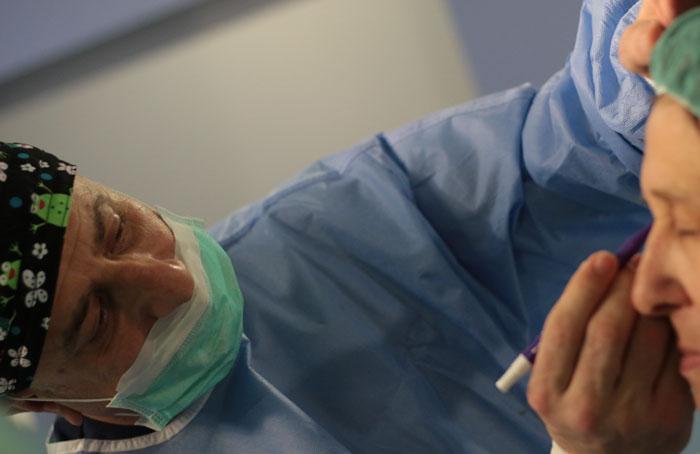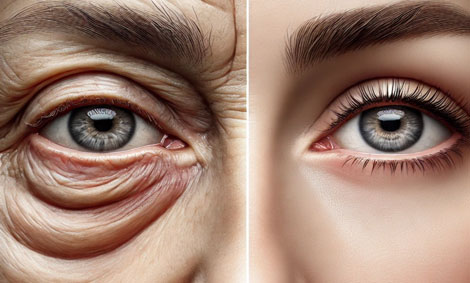Oculoplastic
Blepharoplasty, commonly known as eyelid surgery, is a surgical procedure that aims to improve the appearance and function of the eyelids. It is one of the most frequently performed cosmetic surgeries worldwide, addressing both aesthetic concerns and functional impairments caused by excess skin, muscle, and fat around the eyes. Blepharoplasty can be performed on the upper eyelids, lower eyelids, or both, and it is often sought by individuals seeking to rejuvenate their appearance or improve vision obstructed by drooping eyelids. This paper provides an in-depth review of blepharoplasty, covering its indications, surgical techniques, patient selection, potential complications, and postoperative care.

Blepharoplasty is indicated for both cosmetic and functional reasons. The decision to undergo the procedure is often driven by the desire to correct age-related changes in the eyelids, although certain congenital or acquired conditions may also warrant surgery.
Cosmetic Indications
- Excess Upper Eyelid Skin (Dermatochalasis): Over time, the skin of the upper eyelids can lose elasticity and begin to sag, creating a hooded appearance. This condition, known as dermatochalasis, can make the eyes look tired or aged. Cosmetic blepharoplasty removes this excess skin to create a more youthful and refreshed appearance.
- Lower Eyelid Bags: The lower eyelids can develop puffiness or “bags” due to the protrusion of fat pads, which is often exacerbated by aging or genetic factors. Lower blepharoplasty addresses these concerns by repositioning or removing excess fat and skin.
- Fine Wrinkles: Blepharoplasty can also target fine wrinkles around the eyes, particularly on the lower eyelids, by tightening the skin and underlying muscles.
Functional Indications
- Impaired Vision: In severe cases of dermatochalasis, the excess skin of the upper eyelids can droop over the eyelashes and obstruct the visual field, particularly in the upper and outer regions. Functional blepharoplasty is performed to remove this obstruction and restore normal vision.
- Ptosis: Ptosis, or drooping of the upper eyelid margin, can result from weakness of the levator muscle or its tendon. This condition can impair vision and create an asymmetrical appearance. Blepharoplasty may be combined with ptosis repair to correct both the functional and aesthetic aspects.
- Ectropion and Entropion: Ectropion (outward turning of the eyelid) and entropion (inward turning of the eyelid) are conditions that can cause discomfort, irritation, and damage to the ocular surface. Blepharoplasty can correct these eyelid malpositions, improving both function and comfort.
The techniques used in blepharoplasty vary depending on whether the procedure involves the upper eyelids, lower eyelids, or both. The choice of technique also depends on the specific concerns being addressed and the patient’s anatomy.
Upper Blepharoplasty
Upper blepharoplasty involves the removal of excess skin, muscle, and sometimes fat from the upper eyelids. The procedure typically follows these steps:
- Incision Placement: The surgeon makes an incision in the natural crease of the upper eyelid, which helps conceal any postoperative scarring. In some cases, the incision may extend slightly beyond the outer corner of the eye to address lateral hooding.
- Skin and Muscle Excision: Excess skin and a strip of underlying orbicularis oculi muscle are removed. The amount of tissue removed is carefully measured to avoid overcorrection, which could lead to difficulty closing the eyelid (lagophthalmos).
- Fat Removal or Repositioning: Protruding fat pads, particularly the medial fat pad, may be excised or repositioned to reduce puffiness and improve contour. Repositioning the fat can help avoid a hollowed-out appearance, which can occur with excessive fat removal.
- Closure: The incision is closed with fine sutures, and the natural eyelid crease is preserved. Sutures are typically removed after 5-7 days.
Lower Blepharoplasty
Lower blepharoplasty focuses on the lower eyelids, where issues such as puffiness, bags, and wrinkles are addressed. There are two primary approaches to lower blepharoplasty:
- Transcutaneous Approach:
- Incision Placement: An incision is made just below the lower lash line, extending slightly outward if needed.
- Skin and Muscle Excision: Excess skin and muscle may be removed or tightened to smooth the area.
- Fat Removal or Repositioning: Protruding fat pads are either removed or repositioned to fill the tear troughs and create a smoother transition between the lower eyelid and the cheek.
- Closure: The incision is closed with fine sutures, and care is taken to minimize tension on the wound to prevent ectropion.
- Transconjunctival Approach:
- Incision Placement: This approach involves an incision inside the lower eyelid, through the conjunctiva, avoiding external scars.
- Fat Removal or Repositioning: Fat pads are accessed and treated similarly to the transcutaneous approach.
- Skin Resurfacing: In some cases, laser resurfacing or chemical peels may be used to tighten the skin and improve the appearance of fine wrinkles.
The transconjunctival approach is often preferred for younger patients or those with good skin elasticity, as it avoids external scarring and reduces the risk of complications such as ectropion.

Careful patient selection is critical for achieving optimal outcomes in blepharoplasty. A thorough preoperative evaluation includes:
- Medical History: Assessing the patient’s medical history, including any history of dry eye, thyroid disease, hypertension, or bleeding disorders, is essential. These conditions can influence the risk of complications and the overall safety of the procedure.
- Ophthalmologic Examination: A comprehensive eye examination is performed to evaluate visual acuity, tear production, eyelid function, and ocular surface health. Special attention is given to the presence of ptosis, lid laxity, and tear film abnormalities.
- Photographic Documentation: Preoperative photographs are taken from multiple angles to document the patient’s baseline appearance and serve as a reference during surgery and postoperative follow-up.
- Patient Expectations: Discussing the patient’s goals and expectations is crucial. Patients should have a clear understanding of what blepharoplasty can and cannot achieve, and they should be made aware of the potential risks and complications.
- Informed Consent: Obtaining informed consent involves explaining the procedure, potential risks, benefits, and alternatives. Patients should also be informed about the recovery process and the expected timeline for results.
Blepharoplasty is generally considered a safe procedure, but like any surgery, it carries risks of complications. Understanding these potential complications and their management is essential for both the surgeon and the patient.
Common Complications
- Bruising and Swelling: Bruising and swelling are common after blepharoplasty and typically resolve within 1-2 weeks. Cold compresses and head elevation can help reduce these symptoms.
- Infection: Infections are rare but can occur. Prophylactic antibiotics may be prescribed, and any signs of infection, such as increased redness, warmth, or discharge, should be promptly treated with antibiotics.
- Dry Eye: Blepharoplasty can exacerbate dry eye symptoms, particularly in patients with pre-existing dry eye disease. Temporary or permanent dry eye may result from altered tear film dynamics or incomplete eyelid closure. Lubricating eye drops and ointments are commonly used during the postoperative period.
- Ectropion and Entropion: Improper eyelid positioning can result in ectropion (outward turning of the eyelid) or entropion (inward turning of the eyelid). These complications may require further surgical correction.
- Scarring: Although blepharoplasty incisions are placed in natural creases to minimize visible scarring, some patients may develop hypertrophic or keloid scars. Scar massage, silicone gel sheets, or laser therapy can be used to improve the appearance of scars.
- Lagophthalmos: Difficulty in closing the eyes completely (lagophthalmos) can occur if too much skin or muscle is removed. This condition can lead to exposure keratopathy and requires prompt management, including the use of lubricants and, in severe cases, surgical revision.
- Asymmetry: Minor asymmetry between the two eyelids is common after blepharoplasty, but significant asymmetry may require revision surgery.
Rare Complications
- Vision Loss: Although extremely rare, vision loss can occur due to retrobulbar hematoma, which results from bleeding behind the eye. This is a surgical emergency that requires immediate intervention to relieve pressure and restore blood flow to the optic nerve.
- Orbital Hematoma: Orbital hematoma, a collection of blood within the orbit, can cause pain, swelling, and visual disturbances. Prompt surgical drainage may be necessary to prevent permanent damage.
- Intraoperative Complications: Intraoperative complications, such as excessive bleeding or inadvertent injury to the ocular structures, are rare but can occur. Surgeons must be well-prepared to manage these situations to prevent long-term sequelae.
Proper postoperative care is essential to minimize complications and ensure a smooth recovery. Patients should be provided with detailed instructions for postoperative care, including:
- Wound Care: Patients should keep the surgical area clean and dry, and avoid touching or rubbing the eyes. Antibiotic ointment may be prescribed to apply to the incision sites.
- Activity Restrictions: Patients should avoid strenuous activities, heavy lifting, and bending over for at least 1-2 weeks to prevent increased blood pressure and the risk of bleeding. They should also avoid wearing contact lenses until advised by their surgeon.
- Follow-Up Appointments: Regular follow-up appointments are scheduled to monitor the healing process, remove sutures, and address any concerns. Most patients can expect to see significant improvement within 2-4 weeks, with final results visible after several months.
- Symptom Management: Over-the-counter pain relievers can be used to manage discomfort, while cold compresses help reduce swelling and bruising. Patients should be advised to sleep with their head elevated for the first few days to further minimize swelling.
Blepharoplasty is a highly effective surgical procedure for addressing both cosmetic and functional concerns of the eyelids. When performed by an experienced surgeon, it can significantly enhance the appearance of the eyes and improve the patient’s quality of life. Careful patient selection, thorough preoperative evaluation, and meticulous surgical technique are essential for achieving optimal results and minimizing the risk of complications. As with any surgical procedure, informed consent and clear communication of realistic expectations are crucial components of the patient-surgeon relationship. With appropriate postoperative care, most patients experience a smooth recovery and are highly satisfied with the outcomes of their blepharoplasty.
References:
American Society of Plastic Surgeons. (2021). Blepharoplasty: Eyelid surgery. American Society of Plastic Surgeons. Retrieved from https://www.plasticsurgery.org/cosmetic-procedures/eyelid-surgery
Sadick, N. S., Manhas-Bhutani, S., & Krueger, N. (2013). An algorithm for the management of lower eyelid retraction. Journal of Cosmetic Dermatology, 12(3), 203-214. https://doi.org/10.1111/jocd.12035
Hester, T. R., Codner, M. A., & McCord, C. D. (2008). The use of fat grafting in primary and secondary facial rejuvenation. Plastic and Reconstructive Surgery, 121(2), 804-810. https://doi.org/10.1097/01.prs.0000299870.59145.70
us nec ullamcorper mattis, pulvinar dapibus leo.